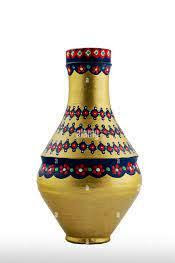The highest art was displayed in the smallest articles, whether of soft pottery, or of the sandy paste before described. Images of deities were moulded in fair style or beautifully carved from steatite, and enamelled with the brilliant blue or green. The scarabaeus--the amulet which signified, as some suppose, creation; as others think, resurrection--was made in pottery as well as steatite, with different symbolic variations, but having the same general form.
Among our specimens is one with the head of an asp; another with the head of Isis; another with the head of a ram, each a work of admirable art. One is of soft pottery, bearing the cartouche of Amasis, 570 B.C., and is a specimen of unusually fine workmanship. The wings are open-work, formed of asps engraved; the back is the head of Isis; the head a ram's head. A scarabaeus in the possession of Mr. Charles Dudley Warner, at Hartford, is skilfully engraved with a life-like head of a hippopotamus. In our collection are crocodiles, snakes, hawks, apes, lions, fish, frogs, cats, a great variety of animal forms, which were made chiefly for ornaments or amulets. Beads and bugles in various colors and shapes were common. It was customary to wrap the dead in shawls composed of net-work, made of bugles and beads with amulets attached. Bugles are often ornamented with spiral lines differing from the general color--black on green, purple on blue, etc. Beads were made globular, angular, oblong, flat with serrated edges, and of other shapes--blue, green, red, and yellow in color.
Enamelled pottery was also used for inlaying purposes in ornamental work. Small tiles, two inches by one, were used in the Pyramid of Sakkara, as in modern chimney decoration. In the Abbott collection (New York Historical Society) and in the Trumbull-Prime collection are numerous specimens of pottery which have been thus used. In the latter collection is an unusually large plaque, 4 3/4 by 4 inches, the eye of Osiris (as this design is ordinarily called) being indicated on it in raised lines, the whole covered with a rich dark-green enamel.
At Tel-el Yahoudeh are the remains of a temple, built of crude brick, whose walls were once covered with tiles of a remarkable character, bearing on them the hieroglyphic history, with illustrations, of the deeds of Remeses III., about 1200 B.C. The legends on these are sometimes impressed in blue tiles and inlaid with colored glass. Other have yellow grounds, with impressed legends inlaid in color. Yet others have relief figures of prisoners captured by the king, their dresses and hair inlaid in color.
Tags:
Egyptian Pottery
